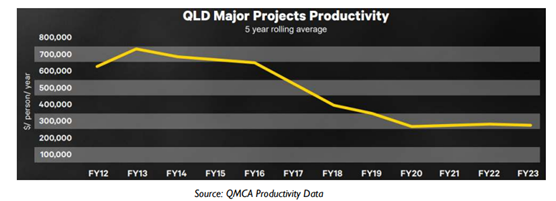

Construction productivity is a hot topic and an important one.
Defined as the measurement of efficiency at completing all the tasks involved in a project within the expected time. Productivity across Australia has dropped and is particularly notable in Queensland.
Currently there is an unprecedented pipeline of infrastructure projects from the Queensland Government’s ‘Big Build’ program (covering health, housing, transport, energy etc.) as well as the infrastructure required to host the 2032 Brisbane Olympic and Paralympic Games.
This is exciting but presents challenges due to the quantum of work and major projects planned to be delivered from now to 2032.
Queensland Major Contractors Association (QMCA) recently published data on Queensland’s major projects and their recorded productivity data.

The graph above shows productivity levels have substantially declined over the last 10 years, with a sharp fall and then consistently lower since COVID-19.
Queensland government’s committed projects and major commercial projects are competing for resources and labour, and industrial relations and policies such as the recently suspended BPIC on government projects, all appear to have contributed to lower productivity. These themes can be deemed an Australia and industry-wide issue.
According to QMCA, for industry to deliver, change is needed. Similarly, the Australian Contractors Association is calling for systemic change across the board to combat the decline in productivity.
This industry-wide change is necessary, but in the meantime, the multi-million-dollar question is:
“What can we do at the coal face to help our clients, and their contractors achieve better project productivity outcomes?”
Or at least, how can we help them to better understand what a realistic time expectation is when it comes to planning, resourcing and allowance that now must be considered in the project programme.
1. Procurement Planning
Planning and programming can assist with the selection of the right procurement and delivery strategy for each project. Whether an ECI, D&C, Lump Sum or two stage MC – through programming the different methods, RCP can provide options to determine the best delivery methodology to aid productivity across each specific project lifecycle. There are many options that need to be considered, and each project should be considered individually in terms a preferred approach.
2. Peer Review
If it sounds too good to be true… it probably is. If your preferred tenderer is shorter on programme (and lower on price) it may pay to have an independent review of their programme (including forensic examination of their native file) to analyse how they are getting there sooner including managing time and potential delays along the project journey. This can bring tenders to a more level playing field to examine which programme is realistic with respect to net durations, assigned working calendar, contingency allowance and risk mitigation, to save delays and overruns down the track.
3. Effective Stakeholder Management
As RCP NZ’s Jason Ward, Senior Design Manager writes in his article here “The ever-growing number of stakeholders for today’s projects is creating an exponential increase in the number of people involved. This surge has made communication and coordination across all groups a significant challenge.” While collaboration is key, more people equal more time.
RCP is implementing advanced communication tools to assist and to enhance stakeholders’ interface. For example, activity interfaces can now be easily understood, and decision making can be made to optimise project schedules and timelines. This is achieved by effectively coordinating and communicating with key stakeholders at the start, followed by the preparation and management of master programmes which highlight interface activities, and associated interdependencies and durations which are then communicated through interactive dashboard reporting.
4. Management of Activity Durations & Delay Contingencies
RCP has witnessed the challenges associated with industry and productivity via impacted project timelines and programmes which contribute to delays, prolonged cashflows and cost overruns.
Of note are the activity durations – for both off-site and on-site works. The off-site works durations are predominantly affected by procurement and supply chain issues including availability of resources and subcontractors. For example, with supply chain, recently it has been proven very difficult to source piling trades and rigs including earthworks machinery, with lead-times being substantially longer in recent times. This leads to contractors recommending advancing critical early works packages and issuing Letters of Intent to key trades earlier than usual to secure them so that the critical upfront works are de-risked as much as possible.
On-site durations have also extended substantially. For example, structural trades are no longer achieving what was they were 10 years ago. Less availability of resources and restrictions of overtime (WHS) and lifestyle changes are resulting in less time on-site meaning lower productivity.
Industrial relations have also contributed to extended net durations. Previously Tier 1 contractors were consistently able to work 6-day week and construction programmes were generally based on a 5.5-day week. However, most contractors now adopt a standard 5-day working week programme calendar. As a result, this leads to an extension of the overall net duration. This is along with change of policies and new rules being applied, such as working with inclement weather, is causing shorter workdays.
All these factors result in an increase in net activity durations.
It is therefore prudent to ensure clients understand this and allow for these considerations when preparing programmes and examine activity durations based on current market conditions to ensure realistic schedules and forecasts are established.
Delay Contingency
Previously, delay allowances were adjusted in the programme depending on the level of risk contractors would take on. The overall delay contingency allowance was then based on a range calculated on the overall net duration. The contingency allowance typically will cover inclement weather, productivity loss, industrial relations, and other unforeseen delays. The overall contingency is often apportioned depending on the stage of the project. For example, a higher percentage of contingency would be allocated in the basement excavation/construction stage than the structure and less would be allocated in the finishes works, given the building would be watertight and not be subject to inclement weather delays.
Post COVID, RCP has recorded an increase in the overall delay contingency allowances on average of the overall net duration, based on completed projects and projects under construction. This is supported by RCP’s benchmarking analysis of a national database of projects.
It is important to work out the required contingency allowance and manage it adequately throughout the project. RCP can provide analyses and advice to ensure your programme has an adequate contingency allowance to cover potential delays based on the specific risks of the project.
5. Deployment of innovative solutions and ideas (including technology)
Simplifying information, data and enhancement of reporting with user friendly information visuals makes communicating complex concepts easier. Particularly for project stakeholders who do not easily read Gantt charts or plans.
Implementing dashboard reporting for client teams and their stakeholders will enable them to easily understand complex data and enhance the communication of project information, allowing for informed decisions to be made faster.
Depicting all data on a single dashboard page to track progress, time and cashflow across master programmes and project-based schedules, has been proven powerful to user group stakeholders. This aids with understanding risks and opportunities and assists with optimisation of project timelines.
——————-
RCP can provide strategic advice to the programming of your project. This is backed by 40+ years of experience as an industry leader of time management, providing specialist planning, programming and delay advisory services to developers, contractors, building owners and government departments.
